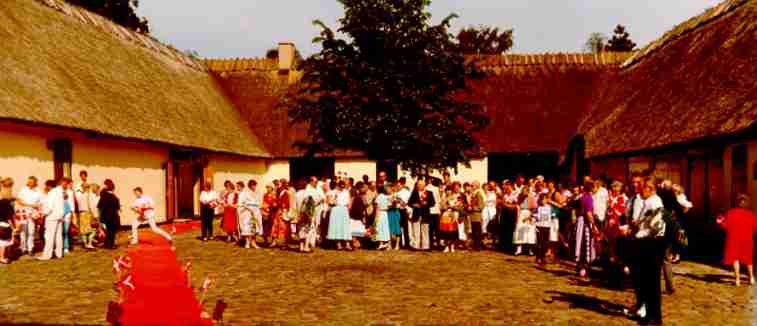Emmas vals (Emma's Waltz) |
| Niels Mejlhede Jensen, Bøgeløvsvej 4, 2830 Virum, Denmark. e-mail (web master) |
CONTENTS: (remember: you can use Ctrl Home in usual browsers to get to the top of this page, to the links here)

Photo of this week: Welcome to our folk dancing in Denmark. The
red carpet is rolled out in the courtyard, and the many Danish flags are
there. The occasion here is special as we are waiting for a fiddler celebrating
his birthday.
Dance of the week, 1999, May 17:
The melody can be heard in midi on computer piano in my tempo (if you
have a sound card). (The melody will loop here until you stop it. In the
table below it will play once). (I have not played the tunes here with
the "drive" I want for dance music).
| 1 | melody | the traditional good dancing melody, polished through generations of use on the fiddle | |
| . | chord
text |
Midi metronome = 160 | simple (folk music) chords, natural for playing the accordion;
these chords are used to make the other parts or voices in triad harmony; there should be no tension from dissonance anywhere including in octave |
| 2 | A | (Above), parallel part nearest above in third or little more above | |
| 3 | B | (Below), parallel part nearest below in third or little more below | |
| 4 | ns | simple n part; often with the tonic feeling and often with the basic dance rhythm ("motor part") | |
| 5 | C1 | C parts are made from A and B parts, and so they are two parts to the melody | |
| 6 | C2 | C2 is less simple than C1 | |
| 7 | mod =
contra part |
voice up and down (mostly) contra to the melody; it is also made from A and B | |
| 8 | n1 | n is a less constricted part, and tones from the melody are freely included | |
| 9 | n2 | . | |
| 10 | n3 | . | |
| 11 | A | octave up | |
| 12 | blank | . | blank staff for making your own part according to the principles here |
Use also octave, up and down.
Where wanted, notes can be changed according to the principles (use
a colour pencil), e.g. to improve the B part with some notes from
A.
The music is aimed at dancing, so part of the orchestra can be the
underlying "motor" when another instrument group is playing its "solo"
part (improvisation) as one of the many repetitions.
The double bass may play its usual notes, because of its low pitch.
It is better to choose a more simple part and play it well.
Accordion: beats per bar: 1+2.
This is folk dance music in minor, so the bass notes should be more
"filled out", should be longer, and less heavily marked than for music
in major. This makes it more difficult to play with good rhythm in an amateur
band and more difficult to dance to for beginners. I feel that the single
bass on beat 1 should last all the way to beat 2 and often even slightly
more. Chord on beat 2 is long, and only chord on beat 3 is stopped with
a thin moment of "air" before the important beat 1. Chords should have
an even sound level. I normally have metronome = 170 for our couple (folk)
dance waltz (160 for family waltz), but for such a lovely waltz in minor
from Finland with its lakes and woods of mystery I play it a little slower:
metronome = 160.
(Help coming back from that note
sheet: CLICK the note sheet to come back to this page, or just close
the note window.
Remember: the note sheet opens in a new separate window, and that may
cover the whole screen. The back button in the tools bar does probably
not work because the window is new, with no history. All you see on the
page are notes because I have placed no link back here for not disturbing
easy submitting to the printer. Close the note window with a click at the
top or with Alt F4, or minimize or reduce the window, or ..., and you are
back to the main page that was there behind all the time).